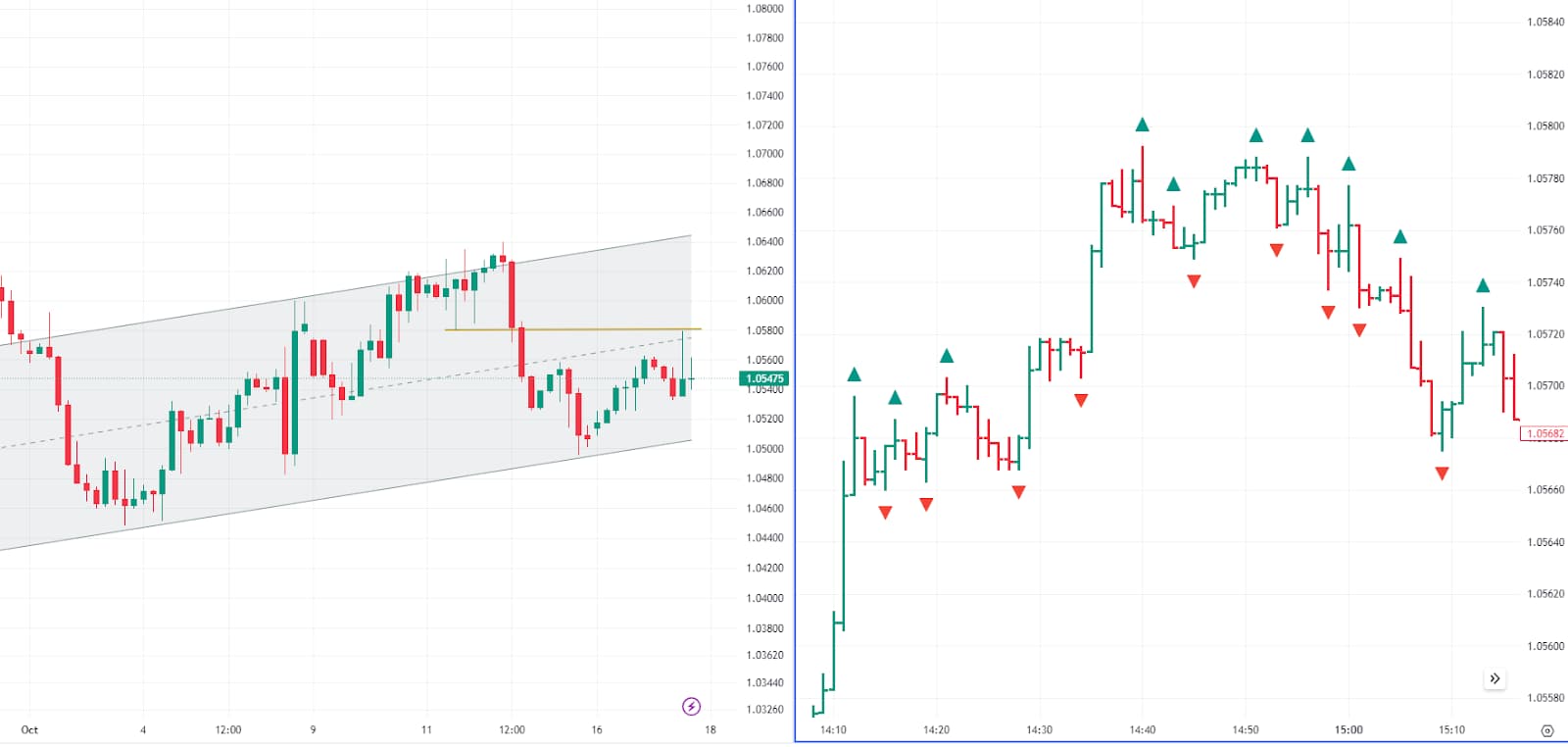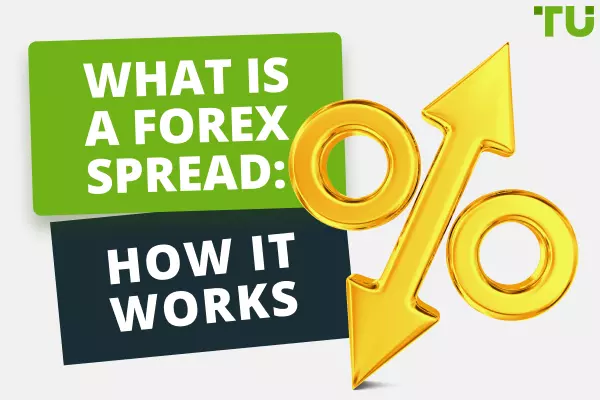Which Forex Timeframe Is The Best For Beginners?
Trading is tricky on any timeframe, but beginners can try combining two timeframes. For example, make a plan on the 4H timeframe and get confirmation to enter a trade on the М15 timeframe.
You can easily switch between the 5-minute, the 15-minute, the 30-minute, or the daily timeframe. But which one to focus on?
Choosing the right time frame is a crucial decision for beginners in the world of Forex trading. While there's no one-size-fits-all answer, many experts recommend starting with longer time frames, like daily or 4-hour charts, as they give more time to plan a trade.
As traders gain experience, they may explore shorter time frames for more frequent trading opportunities.
How to combine time frames for beginners
Time frame is essentially a parameter that determines how often a new candle appears on your chart. Standard time frames include:
1-minute, 5-minute, 15-minute, 30-minute;
1-hour, 4-hour;
daily, weekly.
Each of the time frames has its pros and cons, but beginner traders do not have to focus on only one time frame.

4-hour chart (left), 1-minute chart (right) - Source: Tradingview.com
The screenshot above shows two charts: a 4-hour chart (left) and a 1-minute chart (right).
The higher 4-hour time frame allows a novice trader to find more important support and resistance levels. In the case under consideration, this is the intersection of resistance lines from the median channel line and former support near the level of 1.058.
The 1-minute chart allows you to get trade confirmation and more accurately determine the trade entry point. In the example under consideration, it is opening a short trade when the lower fractal is broken.
By combining timeframes, the novice trader can:
focus on more stable trends visible on higher time frames;
reduce risk by finding entry points and stop-loss levels on lower time frames;
adjust their trading rhythm to suit their personal circumstances;
track multiple markets.
Why is it important to choose the right time frame for beginners?
Traders use different time frames depending on their trading style and strategy. But, selecting a time frame that is too high (long) for your trading strategy and goals can again lead to several problems:
Reduced trading opportunities: Longer time frames, such as weekly or monthly charts, can limit the number of trading opportunities. You may miss out on shorter-term price fluctuations and potential profits.
Slow feedback: Long time frames provide slower feedback on your trades. Determining a trade's success or failure can take weeks or even months, making it challenging to adjust your strategy on time.
Increased risk: Holding positions for an extended period can expose you to higher market risks. Unexpected news events or market shifts can have a significant impact over longer time frames, potentially resulting in larger losses.
Lack of flexibility: Long-term positions can tie up your capital and reduce your ability to take advantage of other short-term opportunities. This can be a problem if you want to diversify your trading or manage risk more actively.
Psychological challenges: Long-term trading requires great patience and discipline. Holding positions for extended periods can be psychologically demanding, especially if the market moves against your position.
Increased costs: Longer time frames can lead to higher trading costs, such as overnight financing fees or interest charges, which can reduce profits.
What to consider when choosing a timeframe for beginners
Various factors, including personal circumstances and level of knowledge, influence the choice of a trading time frame.
Here's how these factors can impact your decision:
1. Personal circumstances
Available time: Your daily schedule and how much time you can dedicate to trading can affect your choice of time frame. If you have a full-time job, you might opt for longer time frames that require less active monitoring.
Financial situation: Your financial circumstances, including the amount of capital you have available for trading, can influence your choice of time frame. Short-term trading often requires more frequent trades and may need a larger capital base to manage risk.
Risk tolerance: Your comfort with risk plays a significant role. Shorter time frames often have more volatility and faster price movements, which can be riskier. Longer time frames may be more suitable for risk-averse individuals.
2. Level of knowledge
Experience:Experience: Beginners might start with longer time frames as they are often less frenetic and allow for a more gradual learning curve. As traders gain experience, they can explore shorter time frames.
Technical analysis skills: Your ability to analyze charts and technical indicators can impact your choice of time frame. Shorter time frames may require more technical analysis skills and the capacity to come up with quick decisions.
Fundamental analysis: If you are more inclined towards fundamental analysis, you might prefer more extended time frames as they are less influenced by short-term news and events.
3. Trading strategy
Your chosen trading strategy is a critical factor. Scalpers often use very short time frames, while swing traders might favor medium-term time frames. Long-term investors, on the other hand, rely on much longer time frames.
4. Psychological factors
Your emotional and psychological makeup is essential. Some traders are better suited to the patience and discipline required for longer time frames, while others thrive on the excitement of shorter time frames.
Best time frame for day trading
For day trading, time frames in the range of 1 to 30 minutes are commonly used. The choice of time frame depends on your trading strategy, risk tolerance, and how closely you want to monitor price movements.
Shorter time frames, like the 1-minute and 5-minute charts, provide more frequent trading opportunities but also require quicker decision-making.
Here's a detailed guide on what day trading is and the best time.
Best time frames for swing trading
Swing trading usually involves holding positions for several days to weeks. The daily chart is popular for analyzing overall market trends and making medium-term trading decisions.
The 4-hour chart can help pinpoint entry and exit points more precisely within those daily trends.
Here's a recommended read to understand the best time frames for swing trading.
Tips on choosing a timeframe for beginners
The best time frame for beginners varies from one person to the other based on their unique circumstances and preferences.
Here's a step-by-step approach to help beginners determine the most suitable time frame:
1. Conduct a personality test
Understand your risk tolerance, patience, and personality traits. Are you comfortable with rapid decision-making and short-term volatility, or do you prefer a more relaxed approach with longer time frames?
2. Try different time frames on a demo account
Open a demo trading account and experiment with various time frames. This helps you to experience different trading speeds and find the one that aligns with your goals. Pay attention to how comfortable you are with the pace and the strategies that work best.
3. Use a trading journal
Keep a trading journal to track your performance in different time frames. Analyze your trades, wins, and losses. Note how well you adapt to each time frame and if you consistently make profits.
4. Evaluate your goals and lifestyle
Consider your daily schedule, available time for trading, and financial goals. If you have a full-time job, you might lean toward longer time frames that require less active monitoring.
5. Match time frame to your trading strategy
Ensure that your selected time frame aligns with your trading strategy. For example, shorter time frames like 1-minute or 5-minute charts might be suitable if you prefer technical analysis and scalping. Weekly or monthly time frames may be better if you are more inclined toward long-term investing.
6. Keep learning
Adapt over time. As you gain experience and knowledge, your ideal time frame may change.
Best Forex brokers 2024


FAQs
What is the easiest time frame to trade on?
In any case, trading is not an easy way to make money. But when trading on the daily timeframe, beginners can reduce the workload associated with the frequency of trading decisions and psychological pressure.
What time frame do scalpers use?
Scalpers usually use very short time frames, often ranging from 1 minute to 15 minutes. This helps to make quick, small trades to profit from minor price fluctuations within a single trading day.
What is the best timeframe for trend reversal trading?
Trends reverse on any timeframe. Which one is the best - may be a question with no clear answer. However, if trend reversal signals come from different timeframes, it can help you make a more informed trading decision.
What are the disadvantages of longer time frames in forex trading?
Longer time frames can lead to fewer trading opportunities, slower feedback, and potentially increased risk exposure in unexpected market events.
Team that worked on the article
Upendra Goswami is a full-time digital content creator, marketer, and active investor. As a creator, he loves writing about online trading, blockchain, cryptocurrency, and stock trading.
Dr. BJ Johnson is a PhD in English Language and an editor with over 15 years of experience. He earned his degree in English Language in the U.S and the UK. In 2020, Dr. Johnson joined the Traders Union team. Since then, he has created over 100 exclusive articles and edited over 300 articles of other authors.
Mirjan Hipolito is a journalist and news editor at Traders Union. She is an expert crypto writer with five years of experience in the financial markets. Her specialties are daily market news, price predictions, and Initial Coin Offerings (ICO).









